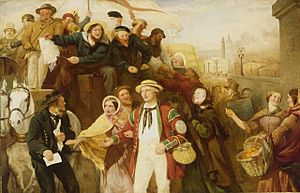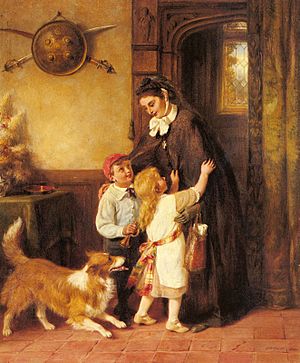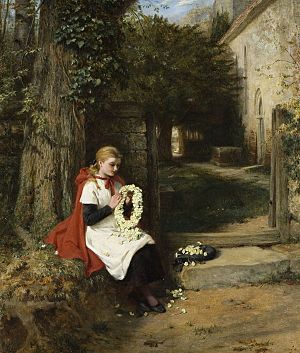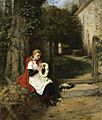George Bernard O'Neill facts for kids
George Bernard O'Neill (born July 17, 1828 – died September 23, 1917) was a very active Irish painter. He was known for his "genre" paintings, which are artworks showing scenes from everyday life. From 1859, he was part of a group of artists called the Cranbrook Colony.
Contents
A Painter's Life and Art
George Bernard O'Neill was born in Dublin, Ireland. He was one of fifteen children! In 1837, when he was nine, he moved to England. He went to school in Woolwich.
Starting His Art Journey
In 1845, George was accepted into the Royal Academy Schools. This was a big art school in London. He was a good student. From 1847, his paintings were shown at the Royal Academy often. He became known for painting lovely story-like scenes. One of his early paintings, 'The Foundling' (1852), showed his skill. It told the story of an orphaned child.
Joining the Cranbrook Colony
In 1855, O'Neill married Emma Stuart Callcott. Her cousin, John Callcott Horsley, was also an artist. Through this marriage, George met other artists. By 1859, he joined the Cranbrook Colony. This was a group of artists who lived and worked together in the countryside.
The next year, George and Emma rented 'Old Wilsley House'. It was an old house near Cranbrook. They used it as a summer home and art studio for many years. This house became the setting for many of O'Neill's paintings.
His Painting Style
O'Neill's art style was similar to his friends, Thomas Webster and Frederick Daniel Hardy. They even worked on a painting together called 'The Surprise'. Hardy painted the room, and O'Neill painted the person in it!
His paintings often showed scenes of country life. They were usually sweet, innocent, and sometimes a little funny. These small, detailed paintings were popular with people in the middle class. They liked art that showed simple, good values.
Success and Public Opinion
O'Neill was most successful from the 1850s to the 1870s. People who owned factories and businesses bought his art. His painting 'Public Opinion' (1863) showed how popular he was. It was displayed at the Royal Academy. Today, you can see it at the Leeds City Art Gallery.
Life in London
Even though he spent summers in Cranbrook, O'Neill also had a home and studio in London. He spent winters there and was part of the city's art scene. In the 1870s, he became friends with James McNeill Whistler. O'Neill supported Whistler when he had a legal problem with an art critic. Even though their art styles were different, both artists believed that art should have a clear purpose.
Stories Through Children
Many of O'Neill's paintings from the Cranbrook Colony show children and country families. They might look like simple, sweet pictures. However, they could have had a deeper meaning. Some people think these paintings were meant to show problems in society.
By showing children, artists could highlight issues without directly attacking the government. They hoped to make people care through feelings, rather than just facts. In this way, O'Neill's paintings of children are like the stories in Charles Dickens' novels. They were part of a bigger movement to improve society at that time.
Later Years
After the 1870s, O'Neill's paintings became less popular. The quality of his work also declined. He passed away in London on September 23, 1917. He was 89 years old. He had not shown any new paintings for the last 24 years of his life.
Images for kids







